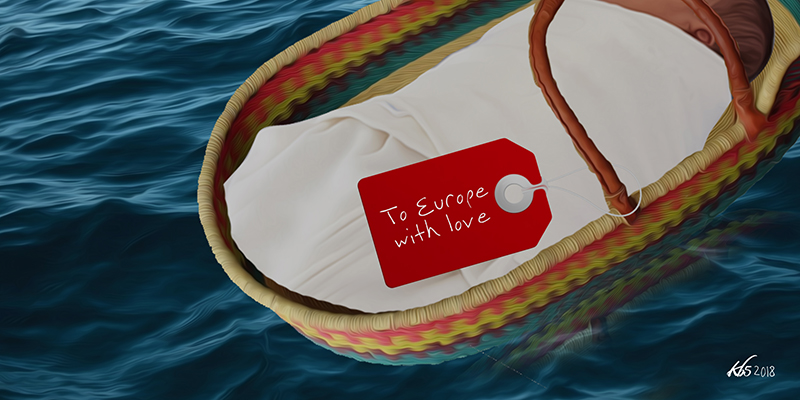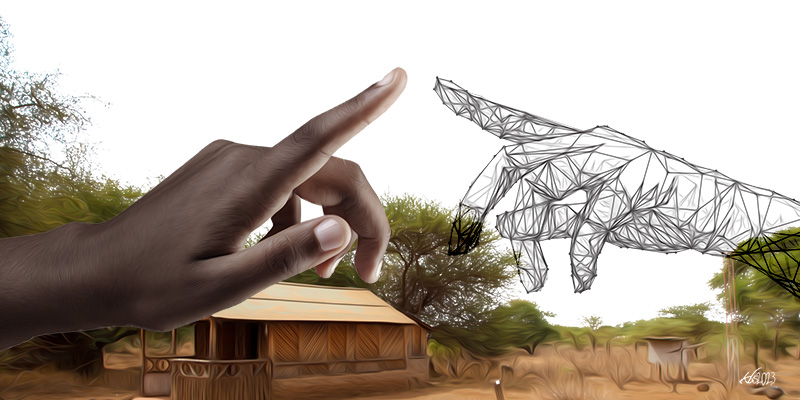The number of immigrants that move to Europe in search of a better future keeps growing year after year, and those who come from sub-Saharan Africa are no exception. Even if the economic conditions of many countries in this region have somewhat improved, the reasons why people keep emigrating have changed, as have the social groups that decide to move to the Western world.
Europe is facing a seemingly endless wave of refugees coming from the Middle East as well, and many countries apparently aren’t able to deal with the ever-increasing number of people who reach their borders and coasts. New rules are needed to distribute these people more fairly across Europe and prevent criminal organisations from exploiting refugees and forcing them into slavery and human trafficking.
As a consequence, many populist and subtly neo-fascist parties have taken power and used immigration as an abhorrent scare tactic to gain popular support. Immigrants and refugees slowly became scapegoats unjustly blamed for all the problems of European countries. Information was manipulated through the use of fake news and social media, and people were misled into believing a significantly distorted version of the reality.
But what is the truth? What are the true numbers of African immigration to Europe? What are the African people who go to Europe going to face once they get there? Is the life of an African immigrant in Europe so much better than the life he lived in his country of origin?
The numbers
The number of international migrant populations coming from countries in sub-Saharan Africa has grown significantly since 2010, especially toward Europe. Among the ten countries with the fastest international migration growth rate, eight are in sub-Saharan Africa. With the exception of Syria, where one of the biggest global humanitarian crisis had displaced millions of refugees, the number of people who emigrated from sub-Saharan Africa grew by 50% – three times more than the 17% worldwide average. This rate has also been much higher between 2010 and 2017 (31%) than in the past, especially in the 1990s, when the growth was just 1%.
With the exception of Syria, where one of the biggest global humanitarian crisis had displaced millions of refugees, the number of people who emigrated from sub-Saharan Africa grew by 50% – three times more than the 17% worldwide average.
Probably one of the most interesting findings on the evolution of the migration phenomenon is that back in the 1990s, 75% of the emigrants moved to another sub-Saharan country, a proportion that dropped to just 68% in 2017. Today, many more sub-Saharan migrants move to Europe, and the number of those who live in European Union countries, Switzerland and Norway reached 17% in 2017 (4.15 million) from 11% in 1990, alongside another 5.2 million North African immigrants.
Most of the sub-Saharan migrants and asylum applicants who come to Europe are from Nigeria, South Africa, Somalia, Senegal, Ghana, Angola, and Kenya. The reasons why migrating is considered a desirable alternative by many sub-Saharan people tend to vary, but are mostly related to finding a job and escaping economic hardship. Although most sub-Saharan African economies are growing, unemployment rates are still high, and wages are quite low, especially for those who possess higher-level qualifications.
And emigrating is not just appealing, it is now easier than in the past. As reported in the New York Times, “incomes per capita in the countries with the largest diaspora populations range roughly from $7,000 to $20,000. Some big African countries — like Nigeria — have entered that range.” Better economic conditions mean that more people are rich enough to afford the journey across the Mediterranean.
Other reasons include political instability and wars, global warming that pushes many people away from their homes, and the wish to reunite with family and friends who already live abroad. But what actually happens once these migrants reach Europe?
The Mediterranean migration and the Dublin Regulation
Once a migrant reaches the European coast, he may seek asylum according to the rules set by the Dublin Regulation. The Dublin Regulation is a European law established in 1997 between the European countries, Switzerland, Iceland, Liechtenstein and Norway. Also called the Dublin III Regulation after it was modified twice in 2003 and 2013, this law regulates which member state is responsible for examining applications of asylum seekers seeking international protection.
The Dublin Regulation does not go in details on how the asylum seekers should be treated, how their application is managed, nor the process through which an application is accepted or rejected; it just defines the responsible country, mostly to prevent an applicant from submitting his or her claim in multiple states. Once the responsible state rejects the asylum seeker’s application, that person is expelled from the European Union and may not restart the process in another member state. Usually, the state responsible for examining the application is either the one where the family and relatives of the asylum seeker reside legally or the one where the seeker first entered the European Union.
In Europe’s highly bureaucratised system, with so many different countries, each one with its own unique laws, the Dublin Regulation is extremely dysfunctional. The first, most obvious consequence of this regulation is that most of the burden of dealing with the constant migratory flows lies on the shoulders of just a few countries. Spain, Greece, and Italy are the countries where the vast majority of African migrants arrive, even if most of the refugees wish to travel to a different destination, such as Germany, which alone saw more than 476,000 new asylum applications in 2015.
In Europe’s highly bureaucratised system, with so many different countries, each one with its own unique laws, the Dublin Regulation is extremely dysfunctional. The first, most obvious consequence of this regulation is that most of the burden of dealing with the constant migratory flows lies on the shoulders of just a few countries.
The second issue is that the entire process is excruciatingly slow. A large number of migrants who barely survived their trip across the Mediterranean in flimsy rubber dinghies or small wooden boats must be first visited, identified and searched immediately after they disembark. They spend their first few days detained in tents and metal holding pens in the ports where they wait in long queues to have their bags searched, their bodies examined by medical personnel, and their belongings thoroughly scrutinised to identify potential smuggling operations. Those fortunate enough to pass this first check must then spend months or even years in reception centres where they often live in inhumane conditions as they wait for their claims to be heard. In 2015, more than one million migrants applied for asylum, but only 292,540 (who probably applied years ago) successfully achieved refugee status.
Most of them choose to refuse identification or flee so they can travel directly to the desired destination, usually the one where they expect better living conditions. Sanctions for this type of irregular travel are minimum at best, and even those who get deported to their original countries can just organise another trip.
The effects on European public opinion
The Dublin system put those countries that represent the external borders of the European Union under significant pressure. Greece, Spain, Italy, and Hungary must deal every year with the brunt of the migratory flows even when they can barely offer asylum seekers the support and protection they rightfully deserve. It is not a coincidence that those countries recently have been invested by a new wave of xenophobia that gave birth and power to many populist parties. Despite the fact that restrictive immigration policies have always failed to contain migration flows from Africa, many Europeans perceive the African immigrants as a threat to their personal and economic security.
Perceptions of the impact of migration have been voluntarily distorted by the media for political reasons. The neurosis of social struggle has been inflamed by manipulating public opinion through scaremongering. Many neo-fascist and populist parties wanted to steer people into making emotional rather than reasoned choices, and the results they achieved with these tactics are, indeed, frightening. Harmful stereotypes, discrimination, and xenophobia, have been used as weapons to control the opinions of European citizens, who now believe that the number of immigrants living in their countries is up to three times higher than the reality. Widespread fear of an alleged “Islamisation” of their culture fueled the rage of the least educated, low-income populations, who now vastly overestimate the number of immigrants who are Muslim and depend on welfare like “social parasites”,
It is easy to understand how making immigrants the scapegoats for the difficulties brought about by the global economic crisis helped the “strongman” political leaders gain vast consensus. Hate towards immigrants has been used to convince the Britons into leaving the European Union with Brexit, to allow Matteo Salvini, a pseudo-fascist Italian political leader who deliberately cites Mussolini, to gain immense traction, and to give the populist Viktor Orban’s government a fourth term in Hungary.
The consequences of African immigration on the real economy
By 2050, more than one-third of European citizens will be aged 60 or older, a reality that will cause the labour demand to go unanswered, with over 20 million qualified jobs exceeding supply. With half of the world’s population growth expected to occur in Africa, sub-Saharan African regions are going to provide almost 800 million new workforce participants that the local economy will likely be unable to absorb. It is easy to understand how African migration may represent an excellent resource to provide a fresh workforce to the aging European economy, rather than the opposite.
It is easy to understand how making immigrants the scapegoats for the difficulties brought about by the global economic crisis helped the “strongman” political leaders gain vast consensus. Hate towards immigrants has been used to convince the Britons into leaving the European Union with Brexit, to allow Matteo Salvini, a pseudo-fascist Italian political leader who deliberately cites Mussolini, to gain immense traction, and to give the populist Viktor Orban’s government a fourth term in Hungary.
But the benefits are even more immediate. Between 2004 and 2014, migrants already accounted for 70% of the increase in the workforce in Europe. A study found that in Europe, low immigration rates between 1995 and 2005 were associated with a constant GDP decrease of 0.23% per year instead of rising by 1.79% per year. Only the excessive rigidity of the European labour market and its restrictive employment protection laws exacerbated the negative impact of immigration on native employment. The European Union is in desperate need of an army of unskilled labourers, to the point that in countries such as Italy, Spain, and Greece, the employment rate of immigrants is now higher than that of native workers. These same countries use populist slogans to target migrants who are accused of being “lazy parasites who live off social security”.
Since employment is the single biggest determinant of a population’s net fiscal contribution, migrants have a positive impact on the public purse. They can, in fact, actively contribute more in taxes than they receive in benefits. Immigrant workers do not depress the wages of native workers either. According to multiple studies, immigration has no negative effects on wages in industrialised countries. Rather, in the long term, immigration increases innovation, productivity, skills variability, and even wage distribution.
Africa will mutually benefit from the migratory flows as well. Money remittance is a powerful economic equaliser; the poorer the region from which the African migrant came from, the higher are the remittances sent back to his or her relatives. To put things in perspective, cash remittances to sub-Saharan Africa totaled a whopping $37.8 billion in 2017, and the World Bank has estimated that they will grow to at least $39.6 billion in 2019.
Since employment is the single biggest determinant of a population’s net fiscal contribution, migrants have a positive impact on the public purse. They can, in fact, actively contribute more in taxes than they receive in benefits. Immigrant workers do not depress the wages of native workers either. According to multiple studies, immigration has no negative effects on wages in industrialised countries. Rather, in the long term, immigration increases innovation, productivity, skills variability, and even wage distribution.
Conclusion
Mediterranean migration is seen only through a strictly Eurocentric perspective, and it’s centered only on the perceived negative effects on the security of the destination countries. European policies frequently promote the human rights abuses perpetrated in North African countries against refugees with the excuse of “dealing with the illegal immigration emergency”. On the other hand, the effects of Western neocolonialism on the socio-economic development of the African continent are often disregarded, although the widespread exploitation of many African lands is one of the principal reasons behind the poverty of these regions.
The highly industrialised countries are in constant need of food and biofuels at the lowest prices possible. Thousands of Africans have been uprooted from their farms to make way for foreign investors to grow food on an industrial scale. In Uganda, 1 million hectares of forest have been lost over the last ten years after the English New Forest Company drove almost 22,000 people from their lands. Anything can be bought and sold if a foreign corporation wants it, even entire villages. The same countries that complain about the never-ending flow of desperate migrants and refugees reaching their coasts are those whose companies paid the gun-toting soldiers who evicted these same migrants and refugees from their homes.
In most European countries, local citizens have seen a significant drop in their real salaries in the last ten years. Most populist parties put their propaganda machines to work to blame the rapid increase in unskilled immigrant labourers for the sharp falls in pay, even if evidence shows that there’s no practical connection.
In truth, the injection of a fresh African workforce in Europe could improve the economy of both continents. Nonetheless, by blocking immigration, the Old Continent guarantees the consolidation of African underdevelopment. But what’s even more depressing is that by letting the hate towards immigrants run rampant, Europe is just sabotaging itself by allowing a handful of dangerous and unscrupulous individuals to gain undeserved political power.
Research by BASSAM HABIB








